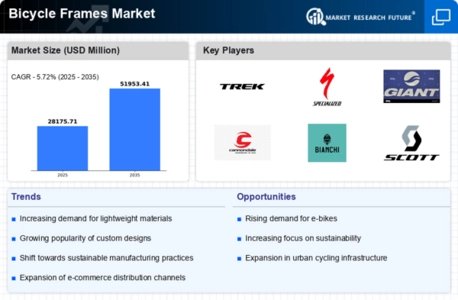Rising Health Consciousness
The increasing awareness of health and fitness among consumers appears to be a significant driver for the Bicycle Frames Market. As individuals seek to incorporate physical activity into their daily routines, cycling emerges as a popular choice. This trend is reflected in the growing sales of bicycles, with the market for bicycle frames projected to reach approximately 5 billion USD by 2026. The emphasis on outdoor activities and eco-friendly transportation options further fuels this demand. Consequently, manufacturers are focusing on producing lightweight and durable bicycle frames that cater to the needs of health-conscious consumers. The Bicycle Frames Market is likely to benefit from this shift towards healthier lifestyles, as more people opt for cycling as a viable means of exercise and recreation.
Customization and Personalization Trends
The demand for customization in the Bicycle Frames Market is on the rise, as consumers seek unique products that reflect their personal style and preferences. This trend is evident in the increasing popularity of bespoke bicycle frames, which allow customers to select specific materials, colors, and designs. Market data suggests that the customization segment is growing rapidly, with consumers willing to pay a premium for personalized options. This shift towards individualization is prompting manufacturers to offer more flexible production processes and design options. The Bicycle Frames Market is likely to benefit from this trend, as it caters to a diverse range of consumer tastes and fosters brand loyalty through personalized experiences.
Environmental Awareness and Sustainability
The growing emphasis on environmental sustainability is reshaping consumer preferences, thereby impacting the Bicycle Frames Market. As awareness of climate change and pollution increases, more consumers are seeking eco-friendly transportation alternatives. Bicycles, particularly those made from sustainable materials, are gaining traction as a viable solution. The market for bicycle frames is expected to witness a surge in demand for frames constructed from recycled or biodegradable materials. This shift aligns with broader sustainability goals, as cycling reduces carbon footprints and promotes healthier lifestyles. The Bicycle Frames Market is likely to see innovative designs and materials that cater to environmentally conscious consumers, reflecting a significant trend towards sustainability.
Technological Innovations in Bicycle Design
Technological advancements are playing a crucial role in shaping the Bicycle Frames Market. Innovations in materials, such as carbon fiber and aluminum alloys, have led to the development of lighter and more durable bicycle frames. Additionally, the integration of smart technology, including GPS tracking and performance monitoring systems, is becoming increasingly popular among consumers. These advancements not only enhance the cycling experience but also attract a broader audience, including tech-savvy individuals. The Bicycle Frames Market is expected to continue evolving as manufacturers invest in research and development to create cutting-edge products that meet the demands of modern cyclists. This focus on innovation may drive market growth and expand consumer choices.
Urbanization and Infrastructure Development
Urbanization continues to reshape transportation dynamics, thereby influencing the Bicycle Frames Market. As cities expand, the demand for sustainable and efficient transportation solutions rises. Many urban areas are investing in cycling infrastructure, such as dedicated bike lanes and parking facilities, which encourages more individuals to adopt cycling as a primary mode of transport. This trend is supported by data indicating that cities with robust cycling infrastructure experience a notable increase in bicycle usage. The Bicycle Frames Market is poised to capitalize on this urban shift, as manufacturers adapt their offerings to meet the needs of urban cyclists. The integration of bicycle frames into urban mobility strategies suggests a promising future for the industry.



.webp)
.webp)
.webp)
.webp)
.webp)
.webp)








Leave a Comment